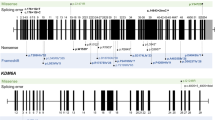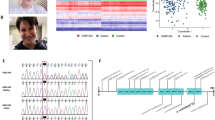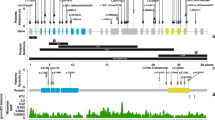Abstract
Kabuki syndrome (KS) is a rare multiple congenital anomaly/mental retardation syndrome. It is characterized by a distinct facial appearance, mental retardation, postnatal growth retardation, skeletal anomalies, unusual dermatoglyphics and fetal fingertip pads. It has previously been speculated that KS is caused by a microdeletion or duplication. In a recent report, an interstitial microduplication of 8p22–23.1 was presented in several cases with this disorder. We investigated 10 Caucasian patients diagnosed with KS by fluorescence in situ hybridization and microsatellite markers located on 8p22–23.1. Using the same clones that were previously reported to be duplicated on chromosome 8p, we could exclude the duplication in all our patients. In addition, we performed a genome-wide screening on this group of patients using array-based comparative genomic hybridization containing BAC clones spaced at approximately 1 Mb intervals across the genome and could not find any evidence for gene dose alterations. The characteristics of KS are variable, a fact that complicates the diagnosis of this disorder. It is possible that we will find genetic heterogeneity among Kabuki patients, and therefore it is unlikely that all patients have an interstitial 8p duplication. We conclude that the etiology of KS remains to be solved and further genetic studies are necessary to delineate its genetic cause.
Similar content being viewed by others
Log in or create a free account to read this content
Gain free access to this article, as well as selected content from this journal and more on nature.com
or
References
Kuroki Y, Suzuki Y, Chyo H, Hata A, Matsui I : A new malformation syndrome of long palpebral fissures, large ears, depressed nasal tip, and skeletal anomalies associated with postnatal dwarfism and mental retardation. J Pediatr 1981; 99: 570–573.
Niikawa N, Matsuura N, Fukushima Y, Ohsawa T, Kajii T : Kabuki make-up syndrome: a syndrome of mental retardation, unusual facies, large and protruding ears, and postnatal growth deficiency. J Pediatr 1981; 99: 565–569.
Matsumoto N, Niikawa N : Kabuki make-up syndrome: a review. Am J Med Genet 2003; 117C: 57–65.
Wessels MW, Brooks AS, Hoogeboom J, Niermeijer MF, Willems PJ : Kabuki syndrome: a review study of three hundred patients. Clin Dysmorphol 2002; 11: 95–102.
Kirchhoff M, Rose H, Lundsteen C : High resolution comparative genomic hybridisation in clinical cytogenetics. J Med Genet 2001; 38: 740–744.
Ness GO, Lybaek H, Houge G : Usefulness of high-resolution comparative genomic hybridization (CGH) for detecting and characterizing constitutional chromosome abnormalities. Am J Med Genet 2002; 113: 125–136.
Shaw-Smith C, Redon R, Rickman L et al: Microarray based comparative genomic hybridisation (array-CGH) detects submicroscopic chromosomal deletions and duplications in patients with learning disability/mental retardation and dysmorphic features. J Med Genet 2004; 41: 241–248.
Vissers LE, de Vries BB, Osoegawa K et al: Array-based comparative genomic hybridization for the genomewide detection of submicroscopic chromosomal abnormalities. Am J Hum Genet 2003; 73: 1261–1270.
Schoumans J, Anderlid BM, Blennow E, Teh BT, Nordenskjold M : The performance of CGH array for the detection of cryptic constitutional chromosome imbalances. J Med Genet 2004; 41: 198–202.
Schoumans J, Nielsen K, Jeppesen I et al: A comparison of different metaphase CGH methods for the detection of cryptic chromosome aberrations of defined size. Eur J Hum Genet 2004; 12: 447–454.
Milunsky JM, Huang XL : Unmasking Kabuki syndrome: chromosome 8p22–8p23.1 duplication revealed by comparative genomic hybridization and BAC-FISH. Clin Genet 2003; 64: 509–516.
Birney E, Andrews D, Bevan P et al: Ensembl 2004. Nucleic Acids Res 2004; 32 (Database issue): D468–470.
Iafrate AJ, Feuk L, Rivera MN et al: Detection of large-scale variation in the human genome. Nat Genet 2004; 36: 949–951.
Miyake N, Harada N, Shimokawa O et al: On the reported 8p22–p23.1 duplication in Kabuki make-up syndrome (KMS) and its absence in patients with typical KMS. Am J Med Genet 2004; 128A: 170–172.
Giglio S, Broman KW, Matsumoto N et al: Olfactory receptor-gene clusters, genomic-inversion polymorphisms, and common chromosome rearrangements. Am J Hum Genet 2001; 68: 874–883.
Engelen JJ, Moog U, Evers JL, Dassen H, Albrechts JC, Hamers AJ : Duplication of chromosome region 8p23.1—>p23.3: a benign variant? Am J Med Genet 2000; 91: 18–21.
Tsai CH, Graw SL, McGavran L : 8p23 duplication reconsidered: is it a true euchromatic variant with no clinical manifestation? J Med Genet 2002; 39: 769–774.
Ishkanian AS, Malloff CA, Watson SK et al: A tiling resolution DNA microarray with complete coverage of the human genome. Nat Genet 2004; 36: 299–303.
Acknowledgements
We are greatly indebted to the patients and their parents. We also thank our Clinical colleagues from Swedish and Danish pediatric departments for referring the patients and the Welcome Trust Sanger Institute, UK for providing the BAC clones. This work was supported by funds from the Swedish Medical Research Council, Frimurarna Barnahuset Foundation, Linnea och Josef Carlsson Stiftelse, Stiftelsen Sävstaholm and the Ronald McDonald Child Foundation.
Author information
Authors and Affiliations
Corresponding author
Rights and permissions
About this article
Cite this article
Schoumans, J., Nordgren, A., Ruivenkamp, C. et al. Genome-wide screening using array-CGH does not reveal microdeletions/microduplications in children with Kabuki syndrome. Eur J Hum Genet 13, 260–263 (2005). https://doi.org/10.1038/sj.ejhg.5201309
Received:
Revised:
Accepted:
Published:
Issue date:
DOI: https://doi.org/10.1038/sj.ejhg.5201309
Keywords
This article is cited by
-
Molecular karyotyping in 17 patients and mutation screening in 41 patients with Kabuki syndrome
Journal of Human Genetics (2009)
-
Array-CGH in patients with Kabuki-like phenotype: Identification of two patients with complex rearrangements including 2q37 deletions and no other recurrent aberration
BMC Medical Genetics (2008)
-
Large-scale copy number variants (CNVs): Distribution in normal subjects and FISH/real-time qPCR analysis
BMC Genomics (2007)
-
BAC-FISH refutes report of an 8p22–8p23.1 inversion or duplication in 8 patients with Kabuki syndrome
BMC Medical Genetics (2006)



